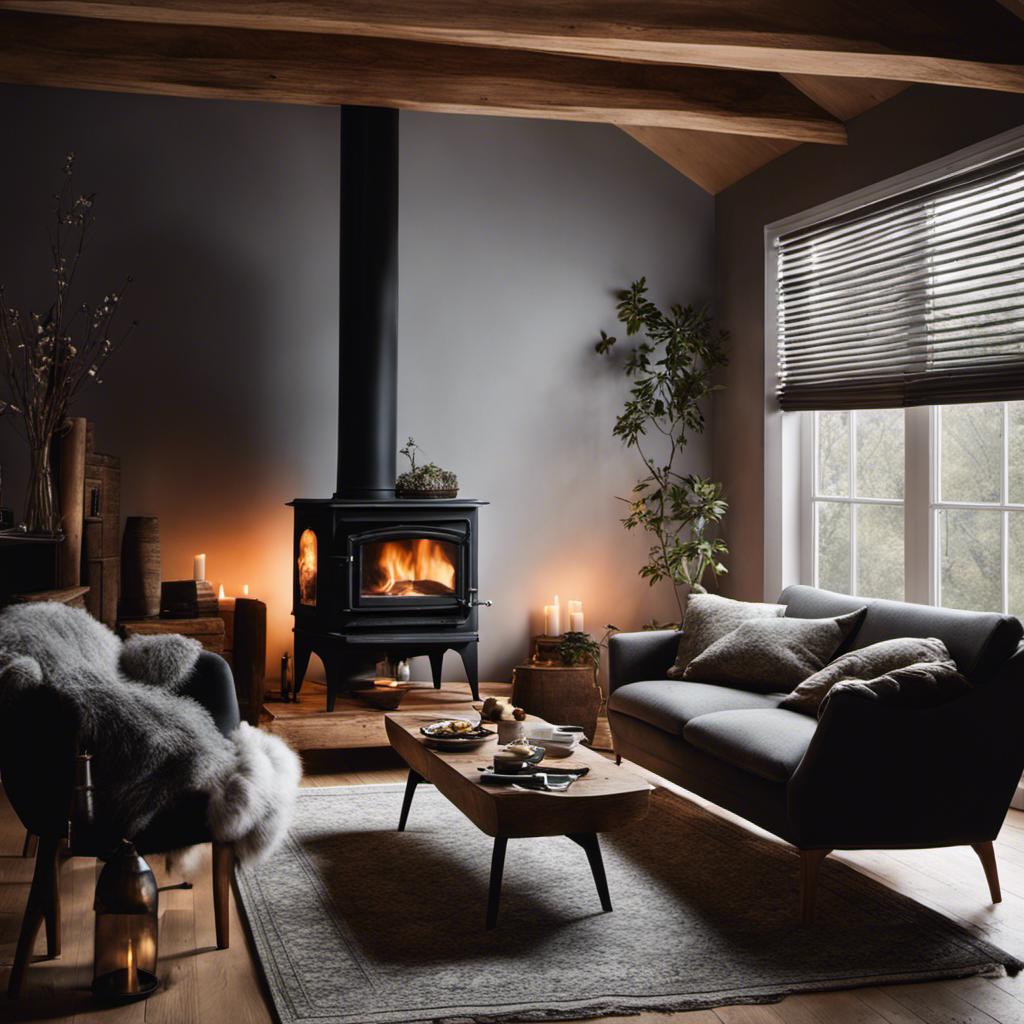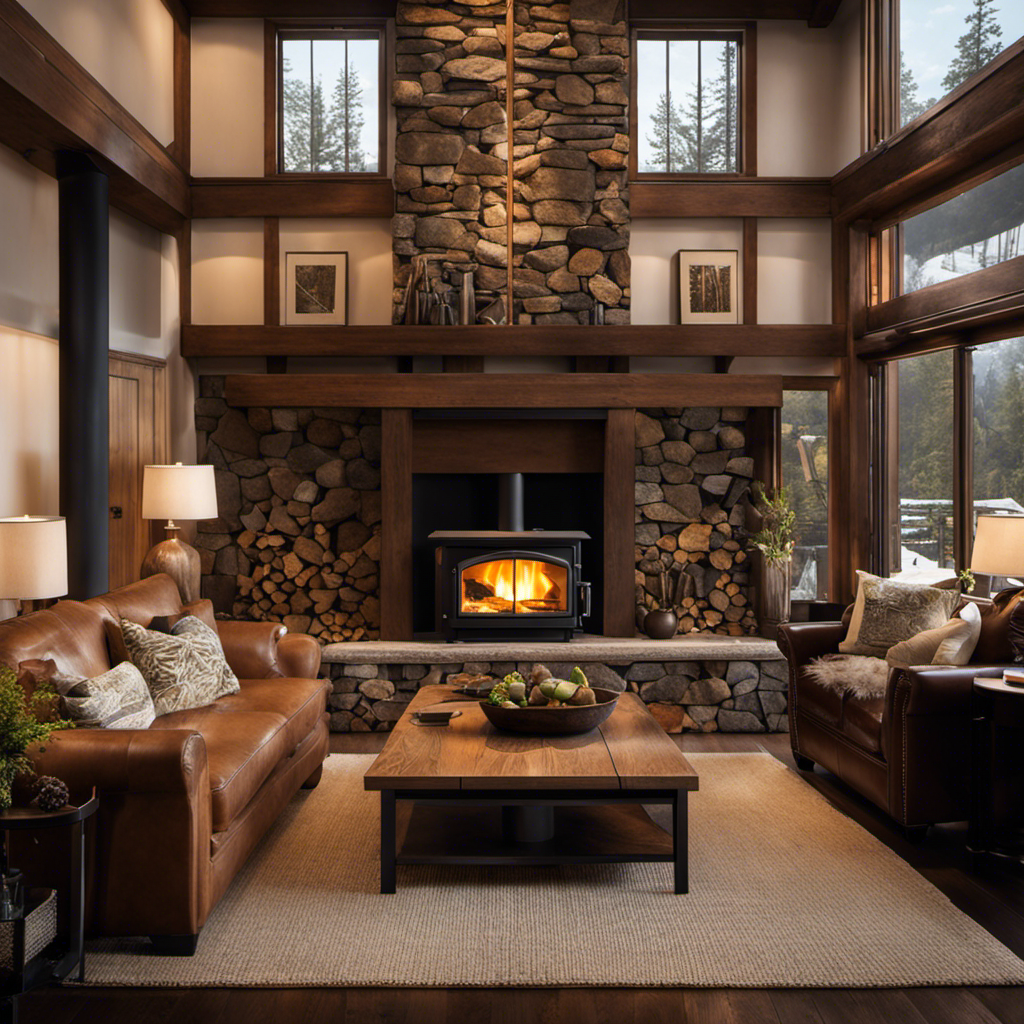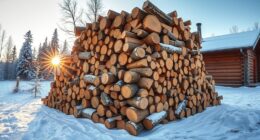Isn’t there something special about snuggling up by the fire only to find out your wood stove has chosen to engulf the room in smoke? As someone who owns a wood stove, I’ve found myself in this frustrating predicament more often than I care to acknowledge.
But fear not, my fellow smoke-filled room sufferers, for I have delved into the depths of wood stove knowledge to uncover the common causes and solutions for this smoky predicament.
So sit back, relax, and let’s get to the bottom of why your wood stove is smoking on occasion.
Key Takeaways
- Improperly starting the fire with wet or unseasoned wood and insufficient airflow to the firebox are common causes of smoke in wood stoves.
- Understanding draft and airflow issues, such as weather conditions and improper placement of the wood stove, is important in preventing smoke.
- Proper wood selection and preparation, including using dry and seasoned wood with ideal moisture content, can help minimize smoke and creosote-related issues.
- Regular chimney inspection, cleaning, and maintenance, along with ensuring proper airflow and removing obstructions, are essential in reducing smoke in wood stoves.
Common Causes of Smoke in Wood Stoves
I sometimes wonder if there’s a simple solution to the common causes of smoke in wood stoves. Troubleshooting smoke issues can be a frustrating task, but understanding the common mistakes in wood stove operation can help identify the root cause.
One common mistake isn’t properly starting the fire. It’s crucial to use dry and well-seasoned wood to ensure a clean burn.
Another mistake isn’t providing enough air to the firebox. Insufficient airflow can lead to incomplete combustion, resulting in smoke production.
Additionally, a dirty chimney or flue can obstruct the flow of smoke, causing it to back up into the room.
By addressing these common mistakes, we can minimize smoke issues and improve the overall performance of our wood stoves.
Understanding draft and airflow issues will further enhance our ability to troubleshoot and resolve smoke problems.
Understanding Draft and Airflow Issues
There are several factors that can contribute to draft and airflow issues when using a wood stove. One of the key factors is the effects of weather conditions on the wood stove draft. In cold weather, for example, the chimney may be cooler than the outside air, causing a reverse draft and preventing proper airflow. This can lead to smoke backflow into the room.
Another important factor is the impact of stove placement on airflow in the room. If the wood stove is placed too close to a wall or furniture, it can disrupt the natural flow of air, resulting in poor combustion and increased smoke production. It’s crucial to ensure proper clearance around the stove to allow for adequate airflow and prevent smoke-related issues.
Additionally, factors such as chimney height, damper position, and flue size play a significant role in maintaining optimal draft and airflow. By considering these factors, wood stove users can minimize draft and airflow issues, ensuring a clean and efficient burning experience.
Importance of Proper Wood Selection and Preparation
When selecting and preparing wood for my wood stove, it is important to consider both the type of wood and the moisture content, as they directly impact the efficiency and performance of the stove. The moisture content of the wood is crucial because wet or green wood can lead to inefficient combustion, excessive smoke, and creosote buildup in the chimney. To emphasize this point, let’s take a look at the table below:
| Type of Wood | Ideal Moisture Content | Effects of High Moisture Content |
|---|---|---|
| Hardwood | 20% or lower | Inefficient combustion, excess smoke, creosote buildup |
| Softwood | 15-25% | Faster burn rate, increased creosote production, more smoke |
| Seasoned wood | Less than 20% | Efficient combustion, minimal smoke, reduced creosote buildup |
Proper firewood storage is essential to maintain the desired moisture content. Storing wood in a dry, well-ventilated area and allowing it to season for at least six months will help reduce its moisture content. By carefully selecting and preparing wood with the right moisture content, I can ensure that my wood stove operates efficiently, providing me with a warm and comfortable environment while minimizing smoke and creosote-related issues.
How to Check and Maintain the Chimney and Flue
Before lighting a fire, it’s important to regularly check and maintain the chimney and flue to ensure proper ventilation and prevent potential hazards. Neglecting chimney inspection and flue maintenance can lead to various issues, including poor airflow, smoke backdraft, and even chimney fires.
To avoid these problems, here are some crucial steps to follow:
-
Chimney Inspection:
-
Hire a professional chimney sweep to inspect and clean the chimney annually.
-
Look for signs of creosote buildup, such as a strong smoky odor or black residue on the walls.
-
Flue Maintenance:
-
Ensure the flue damper opens and closes properly.
-
Remove any obstructions, such as bird nests or debris, from the flue.
Regular chimney inspection and flue maintenance are essential for a safe and efficient wood stove operation. By taking these precautions, you can minimize the risks associated with chimney and flue issues, ensuring a comfortable and smoke-free environment in your home.
Tips and Tricks for Reducing Smoke in Your Wood Stove
I’ve found that by using dry and seasoned wood, I can greatly reduce the amount of smoke in my wood stove. When the wood is wet or green, it produces more smoke and creates a smoldering fire. This leads to inefficient combustion and increased smoke production.
Another important factor to consider is the airflow in the stove. Insufficient airflow can cause smoke to back up into the room. Troubleshooting smoke issues involves making sure the chimney is clear of any blockages, such as creosote buildup or debris.
Additionally, using a stove fan can improve airflow by distributing the heat more evenly throughout the room and helping to push the smoke up and out of the chimney.
Frequently Asked Questions
How Can I Tell if My Wood Stove Is Producing Too Much Smoke?
To troubleshoot wood stove smoke and reduce it, check for proper airflow, use dry and seasoned wood, and ensure a clean chimney. Additionally, adjusting the damper and using smaller, hotter fires can help minimize smoke production.
Are There Any Health Risks Associated With Wood Stove Smoke?
Health effects and air pollution are important considerations when it comes to wood stove smoke. It’s crucial to understand the potential risks associated with exposure to smoke in order to protect your health and maintain good indoor air quality.
Can a Wood Stove Smoke Problem Be Fixed Without Professional Help?
Fixing a wood stove smoke problem without professional help is possible. With troubleshooting techniques and DIY solutions, you can identify issues like poor airflow or a dirty chimney, and take steps to resolve them. Remember, where there’s smoke, there’s fire.
Why Does My Wood Stove Only Smoke Sometimes and Not All the Time?
Sometimes my wood stove smokes and fills the room due to factors like improper air flow, wet or unseasoned wood, or a dirty chimney. Regular wood stove maintenance and troubleshooting can help prevent these issues.
Are There Any Regulations or Guidelines Regarding Wood Stove Smoke Emissions?
There are regulations and guidelines in place to control wood stove smoke emissions. These rules help ensure that wood stoves operate efficiently and minimize the amount of smoke released into the room.
Conclusion
After exploring the common causes of smoke in wood stoves, understanding draft and airflow issues, and emphasizing the importance of proper wood selection and preparation, it’s clear that maintaining the chimney and flue is crucial.
By regularly checking and cleaning these components, you can ensure efficient airflow and minimize smoke in your wood stove.
Remember, a little maintenance goes a long way in ensuring a smoke-free and enjoyable wood stove experience.
So, don’t let smoke ruin your cozy nights by the fire – take care of your chimney and flue!











